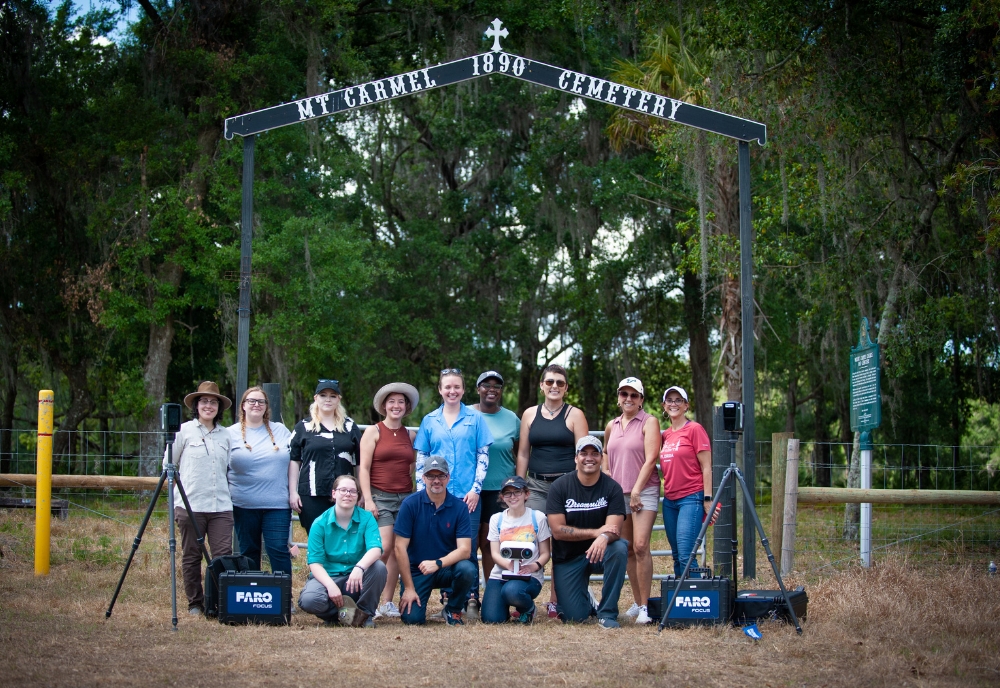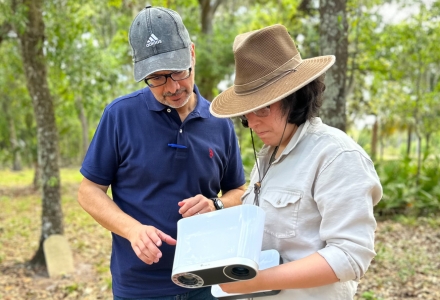
Dr. Davide Tanasi and IDEx member Victoria Giralt calibrating a structured light 3D scanner employed to 3D digitize the tombstones of the cemetery. (Photo courtesy of IDEx)
The USF College of Arts and Sciences’ (CAS) Dr. Antoinette Jackson, anthropology chair and director of the Living Heritage Institute and Story Studio (LHI) and Black Cemetery Network (BCN), has joined forces with Dr. Davide Tanasi, history professor and director of the Institute for Digital Exploration (IDEx), to preserve Mt. Carmel Cemetery, a historically Black cemetery in Pasco County, via 3D digitization techniques.
This interdisciplinary collaborative effort was kickstarted from an inquiry the BCN received from Pasco County asking for help in researching and preserving Mt. Carmel Cemetery, which was founded in the mid-1800s in New Port Richey, Fla.
Two students in Jackson’s anthropology course, Issues in Heritage Tourism, Jonathan Rodriguez and Mary Maisel, both majoring in archaeology, conducted preliminary archival research and updated ground penetrating radar results, according to Jackson, and shared their initial findings with Pasco County. Kerri Knigge Klein, another CAS student also majoring in archaeology and a member of the IDEx lab, helped to advance these efforts as well.
Now the interdisciplinary group of CAS faculty and students are bringing their expertise together to work on a pilot study at the site with the goal of digitally preserving Black cemeteries through targeted community-based projects. Jackson is serving as principal investigator (PI) and Tanasi as co-PI of the study.
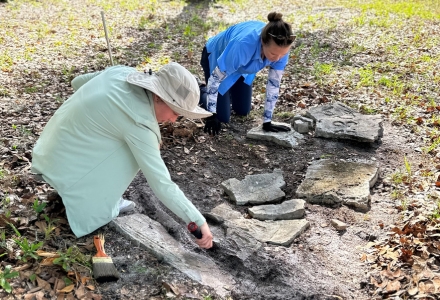
Mary Maisel (anthropology department and LHI) and Sarah Hassam (history department and IDEx) cleaning a tomb in preparation for the 3D digitization. (Photo courtesy of IDEx)
3D digitization is the process of creating a three-dimensional digital representation via the use of 3D capturing devices based on light or laser light emission, according to Tanasi.
In early April, Klein and Tanasi led a digital preservation effort at Mt. Carmel Cemetery, conducting a remote sensing survey of the site.
“Utilizing a host of 3D digital imaging techniques, such as terrestrial laser scanning, structured light 3D scanning and digital photogrammetry, the Mt. Carmel cemetery and the extant tomb stones were recorded in their current state for perpetuity,” Tanasi explained.
Rodriguez and Maisel, along with other students and members of the LHI and BCN, guided the IDEx team through the site, indicating the surviving tombstones and pointing to other important features. The teams also cleared foliage from graves and cleaned tombstones during the process.
The IDEx team then conducted the overall 3D digitization of the entire plot of land containing the cemetery via terrestrial laser scanning and 3D digitized nine graves and related tombstones via structure light 3D scanning.
“This collaboration between IDEx and LHI/BCN is one that will showcase ways USF teams can contribute to preservation efforts at cemetery sites, particularly historic Black cemeteries that have in many cases been damaged, erased, marginalized or undocumented,” Jackson said. “The BCN is facilitating projects and partnerships like these in order to make Black cemeteries and their histories, which essentially are histories of entire communities, part of the public record and available for all of us to learn from. Digital preservation is another way of telling or adding to the story.”
IDEx "creates an interactive web-hosted map so that the identities and stories of the individuals interred here are not lost forever.”
The 3D digitization was carried out over two days at the site, with the processing of the data and the production of the 3D models taking about one month before recently being completed, according to Tanasi.
However, their efforts did not go unchallenged.
“The main challenge was the overgrown vegetation,” Tanasi said. “The plot of land is covered by trees with large canopies projecting a lot of shadows and interfering with our systems that work better in uniform light conditions. Additionally, one tombstone had the name and dates incised on it almost completely unreadable due to the effect of atmospheric agents. For this reason, we used a special photographic and visualization technique on it named Reflectance Transformation Imaging to digitally enhance readability and obtain more information.”
The resulting 3D models will be distributed for free to a wide audience via the IDEx web infrastructure, according to Tanasi, and can potentially be used to track changes at the cemetery over time.
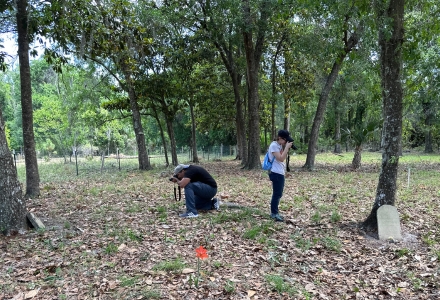
Jonathan Rodriguez (anthropology department and LHI) and Sophia Almeida (history department and USF IDEx) take photos of markers. (Photo courtesy of IDEx)
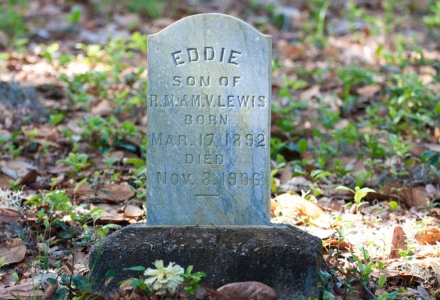
A tombstone the team cleared at the site. (Photo courtesy of IDEx)
“It creates an interactive web-hosted map so that the identities and stories of the individuals interred here are not lost forever,” he said.
Jackson said she wants to make sure that technology as a method does not supersede other methods and forms of preserving and remembering a site but, rather, that it compliments it.
“Digital preservation helps expand ways of knowing and learning about Mt. Carmel Cemetery and who was buried there,” she said. “It also helps preserve a snapshot of the cemetery site at a moment in time and make it available to a broader audience. It provides another form of knowledge about the site but remains one aspect of knowing along with ethnography, oral history, archival research and maps for example.”
Tanasi said IDEx, LHI, and BCN leaders hope to use this project as a model to apply to other Black cemeteries, and to train descendant communities and volunteers to digitally record cemeteries in their own areas to enhance the BCN database.
